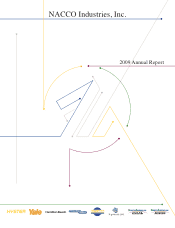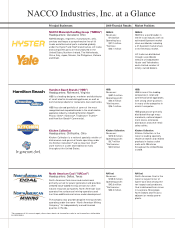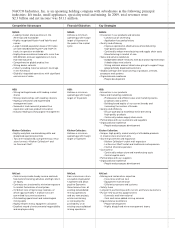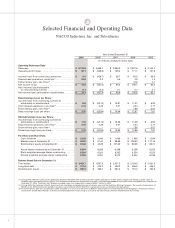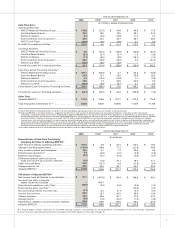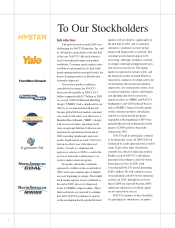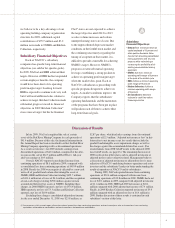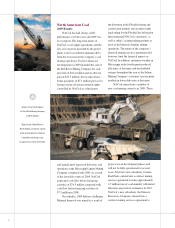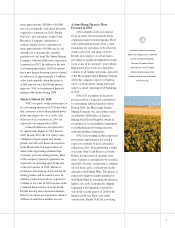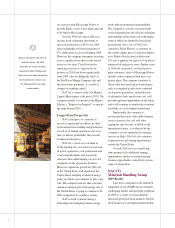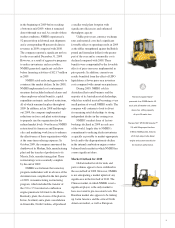Hamilton Beach 2009 Annual Report Download - page 10
Download and view the complete annual report
Please find page 10 of the 2009 Hamilton Beach annual report below. You can navigate through the pages in the report by either clicking on the pages listed below, or by using the keyword search tool below to find specific information within the annual report.
7
on a project with Mississippi Power to
provide lignite coal to a new plant expected
to be built in Mississippi.
Overall, NACoal expects full-year
income from continuing operations to
increase moderately in 2010 over 2009
after excluding lease bonus payments of
$7.1 million pre-tax received during 2009.
However, the company anticipates receiving
receive significant royalties on the leased
reserves over time. Cash flow before
financing activities is expected to be
positive in 2010, but down significantly
from 2009, after excluding the effect of
the Red River Mining Company sale and
the lease bonus payments, as a result of
changes in working capital.
NACoal’s contract at the San Miguel
Lignite Mine expires at the end of 2010. The
company intends to respond to San Miguel
Electric’s “Request for Proposal” to operate
the mine beyond 2010.
Longer-Term Perspective
NACoal expects to continue its
record of operational excellence in safety,
environmental stewardship and production
at each of its mining operations and, over
time, to deliver profitability that exceeds
its financial objectives.
NACoal’s vision is to continue to
be the leading low-cost miner of coal used
in power generation, coal gasification and
coal-to-liquids plants and to provide
selected value-added mining services for
companies in the aggregates business.
However, significant growth for NACoal
in the United States will depend on the
United States adopting a balanced energy
policy in which coal continues to play a key
role. The company believes that coal must
remain an integral part of the energy mix if
the United States is going to continue to be
fully competitive in a global economy.
NACoal will continue taking a
leadership role in helping balance energy
needs with environmental responsibility.
The company is actively associated with
several organizations involved in evaluating
and studying various clean-coal technologies,
some of which are funded by the federal
government. Also, one of NACoal’s
customers, Basin Electric, is a pioneer in
the carbon capture process, which it employs
at its Dakota Gasification facility to put
CO
2
into a pipeline for export to Canada for
enhanced oil and gas recovery. Further, most
of NACoal’s potential coal-fired power
plant customers, such as Mississippi Power,
include carbon capture in their new coal
project plans. The company continues to
believe that new power plant technologies,
such as integrated gasification combined
cycle power generation, and production
of alternative fuels made from coal, will
provide important opportunities in the future,
and it will continue to monitor the economic
feasibility of coal-to-liquid technologies.
Importantly, the company is
encouraged that more value-added mining
services projects for coal and other
aggregates may become available in the
international arena, as evidenced by the
company’s recent agreement for mining
services in India. NACoal also continues
to pursue non-coal mining opportunities
outside the United States.
Overall, NACoal sees sound long-
term prospects for additional mining
opportunities and has several promising
business opportunities currently in various
stages of negotiation.
NACCO
Materials Handling Group
2009 Results
Like most companies in the industrial
equipment sector, NMHG faced extremely
challenging market and operating conditions
in 2009 as a result of extraordinarily
depressed global lift truck markets. The lift
truck market saw an unprecedented decline
Hyster’s new electric-rider lift truck
series, the Hyster®J45-70XN
pneumatic tire series, has lifting
capacities of 4,500 to 7,000 pounds.
These trucks have been designed for
overall productivity at lower costs.
The 5,000 pound lift truck model
is shown below.

